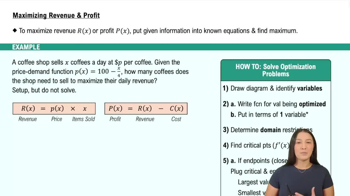Table of contents
- 0. Functions7h 52m
- Introduction to Functions16m
- Piecewise Functions10m
- Properties of Functions9m
- Common Functions1h 8m
- Transformations5m
- Combining Functions27m
- Exponent rules32m
- Exponential Functions28m
- Logarithmic Functions24m
- Properties of Logarithms34m
- Exponential & Logarithmic Equations35m
- Introduction to Trigonometric Functions38m
- Graphs of Trigonometric Functions44m
- Trigonometric Identities47m
- Inverse Trigonometric Functions48m
- 1. Limits and Continuity2h 2m
- 2. Intro to Derivatives1h 33m
- 3. Techniques of Differentiation3h 18m
- 4. Applications of Derivatives2h 38m
- 5. Graphical Applications of Derivatives6h 2m
- 6. Derivatives of Inverse, Exponential, & Logarithmic Functions2h 37m
- 7. Antiderivatives & Indefinite Integrals1h 26m
- 8. Definite Integrals4h 44m
- 9. Graphical Applications of Integrals2h 27m
- 10. Physics Applications of Integrals 2h 22m
5. Graphical Applications of Derivatives
Applied Optimization
Problem 72b
Textbook Question
Another pen problem A rancher is building a horse pen on the corner of her property using 1000 ft of fencing. Because of the unusual shape of her property, the pen must be built in the shape of a trapezoid (see figure). <IMAGE>
b. Suppose there is already a fence along the side of the property opposite the side of length y. Find the lengths of the sides that maximize the area of the pen, using 1000 ft of fencing.
 Verified step by step guidance
Verified step by step guidance1
Identify the variables: Let the lengths of the non-parallel sides of the trapezoid be x and z, and the length of the parallel side opposite to the existing fence be y.
Set up the constraint equation: Since the total amount of fencing available is 1000 ft, and one side is already fenced, the equation is x + y + z = 1000.
Express the area of the trapezoid: The area A of a trapezoid is given by A = (1/2) * (base1 + base2) * height. Here, base1 is y, base2 is the existing fence, and height can be expressed in terms of x and z using the Pythagorean theorem if needed.
Substitute the constraint into the area formula: Solve the constraint equation for one variable, say y = 1000 - x - z, and substitute this into the area formula to express A in terms of x and z.
Use calculus to find the maximum area: Take the partial derivatives of the area function with respect to x and z, set them to zero to find critical points, and use the second derivative test or analyze the critical points to determine which values of x and z maximize the area.
 Verified video answer for a similar problem:
Verified video answer for a similar problem:This video solution was recommended by our tutors as helpful for the problem above
Video duration:
7mPlay a video:
Was this helpful?
Key Concepts
Here are the essential concepts you must grasp in order to answer the question correctly.
Optimization
Optimization in calculus involves finding the maximum or minimum values of a function. In this context, the rancher needs to maximize the area of the trapezoidal pen while adhering to the constraint of 1000 ft of fencing. This typically involves setting up a function for the area in terms of the available dimensions and using techniques such as taking derivatives to find critical points.
Recommended video:

Intro to Applied Optimization: Maximizing Area
Area of a Trapezoid
The area of a trapezoid can be calculated using the formula A = (1/2) * (b1 + b2) * h, where b1 and b2 are the lengths of the two parallel sides, and h is the height. Understanding this formula is crucial for determining how the dimensions of the pen relate to the total area, which the rancher aims to maximize while using the available fencing.
Recommended video:

Estimating the Area Under a Curve with Right Endpoints & Midpoint
Constraints in Optimization Problems
In optimization problems, constraints are conditions that must be satisfied while optimizing a function. In this scenario, the constraint is the total length of fencing available (1000 ft), which limits the dimensions of the trapezoid. Formulating the problem with these constraints allows for the application of methods such as the method of Lagrange multipliers or substitution to find the optimal solution.
Recommended video:

Intro to Applied Optimization: Maximizing Area

 1:13m
1:13mWatch next
Master Intro to Applied Optimization: Maximizing Area with a bite sized video explanation from Callie
Start learningRelated Videos
Related Practice








